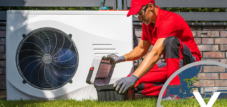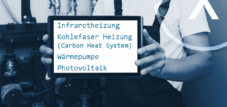Heat pumps are four times more efficient than oil heating systems - but the 70% subsidy is wasted
Language selection 📢
Published on: November 16, 2024 / Update from: November 16, 2024 - Author: Konrad Wolfenstein

Heat pumps are four times more efficient than oil heating systems - but the 70% funding is wasted - creative image: Xpert.Digital
🌡️🔥 Heat pumps: Efficient and environmentally friendly heating technology
♻️🏠 Heat pumps are one of the most efficient technologies for heating buildings and represent an environmentally friendly alternative to traditional heating systems based on fossil fuels such as oil or gas. In recent years the market for heat pumps has developed significantly and their popularity is continually increasing. This is primarily due to their high efficiency and political efforts to reduce CO₂ emissions. However, despite their advantages, there are also challenges, particularly in terms of funding policies and costs for end users.
🌀 How heat pumps work
Heat pumps use energy stored in the environment to heat buildings or provide hot water. They extract heat from the surrounding air, soil or groundwater and convert it into usable energy. They work according to a simple physical principle: a refrigerant evaporates and absorbs heat from the environment. The gaseous refrigerant is then compressed, causing its temperature to rise. This heat can then be transferred to the building's heating system.
There are different types of heat pumps that differ depending on the heat source:
- Air-water heat pumps: They extract heat from the outside air and pass it on to the heating system. This type of heat pump is relatively easy to install and is particularly suitable for milder climates. However, their efficiency can decrease at very low outside temperatures.
- Brine-water heat pumps (geothermal heat pumps): These systems use the constant temperature in the ground. Heat is extracted from the ground via vertically drilled earth probes or horizontally installed earth collectors. Since the ground temperature remains relatively stable all year round, geothermal heat pumps are characterized by high efficiency and reliability.
- Water-water heat pumps: They extract heat from the groundwater. This usually requires two wells – a production well and a drinking well. The groundwater has a constant temperature all year round, making these systems very efficient. However, they require approval and cannot be installed everywhere.
What all of these systems have in common is that they can be operated with relatively little electrical energy. The ratio of electrical energy used to heating energy obtained is called the “Coefficient of Performance” (COP). Modern heat pumps achieve values of 3 to 5, which means that they can generate three to five kilowatt hours of heat for every kilowatt hour of electricity used.
🌿 Efficiency compared to fossil heating systems
Compared to conventional heating systems that rely on fossil fuels such as oil or gas, heat pumps are significantly more efficient. While with oil heating or gas heating a large part of the energy is lost in the form of waste heat, heat pumps make optimal use of the available environmental energy. The efficiency of an oil heater is typically around 85 to 90 percent - this means that 10 to 15 percent of the energy used remains unused. With modern heat pumps, however, the degree of utilization is significantly higher and can be up to 400 percent.
“Heat pumps are four times more efficient than oil heating,” says an analysis by the energy service provider Techem. Specifically, this means that a heat pump delivers four times more energy in the form of heat than a comparable amount of fossil fuel in a conventional heater.
🌱 Sustainability and environmental friendliness
Another key advantage of heat pumps is their environmental friendliness. Since they rely predominantly on renewable energies - be it by using the ambient heat or by operating with green electricity - they make a significant contribution to reducing CO₂ emissions. In contrast, oil or gas heating produces significant amounts of greenhouse gas emissions. According to a study by the Federal Environment Agency, an oil heater causes an average of around 3 tons of CO₂ emissions per year for a single-family home, while a heat pump powered by green electricity works with almost no emissions.
The introduction of legal regulations such as the Building Energy Act (GEG), which from January 1, 2024 stipulates that at least 65 percent of the heating in new buildings must come from renewable energies, underlines the importance of this technology for the energy transition. This regulation is intended to help drastically reduce the proportion of fossil fuels in the heating sector and accelerate the transition to more climate-friendly alternatives such as heat pumps.
💰 Funding and economic aspects
Despite their high efficiency and environmental friendliness, heat pumps are often more expensive to purchase than conventional heating systems. Depending on the type of heat pump and structural conditions, the investment costs can be between 10,000 and 30,000 euros. In order to cushion this additional financial burden, the state offers extensive funding programs.
Homeowners can currently receive up to 70 percent of the investment costs reimbursed through government subsidies when switching to a heat pump. However, this funding is income-dependent: households with lower incomes receive higher subsidies than wealthier households. This is intended to ensure that lower-income households can also benefit from the advantages of the heating transition.
However, there is criticism of the design of these funding programs. Many experts complain that the actual funding conditions are often not as generous as initially announced. “The 70 percent funding is wasted,” criticize some experts, as many applicants do not receive the full funding amount due to strict criteria or have to accept long waiting times.
🛠️ Challenges in implementation
In addition to the financial aspects, there are also technical challenges in the widespread introduction of heat pumps. Not every building is suitable for the use of a heat pump - old buildings in particular with poor insulation often require additional renovation measures in order to be heated efficiently. In addition, the installation of a ground or water heat pump involves more structural work, as drilling or excavation is necessary.
The availability of skilled workers also plays a role: the installation of heat pump systems requires specialized craftsmen, but these are currently in short supply in many places. This not only leads to longer waiting times for end customers, but also to higher installation costs.
Another problem is the dependence on the price of electricity: Since heat pumps are predominantly operated electrically, they are susceptible to fluctuations in the price of electricity. Although some of the electricity required can be generated by using photovoltaic systems in combination with a heat pump, this requires additional investment.
🚀 Key technology for the energy transition in the building sector
Despite these challenges, the heat pump is considered a key technology for the energy transition in the building sector. The EU has set itself the goal of significantly increasing the share of renewable energy in the heating sector by 2030 - heat pumps play a central role in this. In Germany, too, their market share is expected to continue to rise: forecasts assume that around two thirds of all new buildings will be equipped with a heat pump by 2030.
In order to further promote this trend, manufacturers are continually working on further developing their products. New models should work even more efficiently and be able to reliably provide heat even at extremely low outside temperatures - an aspect that is particularly important in colder regions of Europe.
There is also increasing research into how heat pump systems can be better integrated into existing buildings - for example through hybrid systems that are a combination of gas heating and heat pumps.
📈 Wide use of heat pumps
Heat pumps offer numerous advantages over conventional heating systems: They are more efficient, more environmentally friendly and cheaper to operate in the long term. Their introduction is supported by government funding programs, but there are still hurdles to widespread implementation - be it due to high acquisition costs or technical challenges with older buildings.
Nevertheless, one thing remains clear: the heating transition is hardly conceivable without the widespread use of heat pumps. They play a central role in the fight against climate change and at the same time offer the potential for significant savings in heating costs - provided the political framework is right and the technology is further optimized.
📣 Similar topics
- 🌡️ Revolution in heating technology: heat pumps in focus
- 💧 Efficient heating with environmental energy: This is how heat pumps work
- 🔋 Efficiency advantage: heat pumps vs. fossil heating systems
- 🌿 Environmentally friendly and sustainable: heat pumps as a green alternative
- 💰 Funding programs and costs: Which economic aspects are important?
- ⚙️ Overcome challenges: The path to full use of heat pumps
- 📈 Future prospects: Heat pumps on the rise
- 🏡 Widespread use of heat pumps: opportunities for the energy transition
- 🚀 Innovation and development: The next generation of heat pumps
- 🛠️ Technical and economic hurdles on the way to the heat transition
#️⃣ Hashtags: #heat pump #sustainability #energy transition #efficiency #promotion
🎯🎯🎯 Benefit from Xpert.Digital's extensive, fivefold expertise in a comprehensive service package | R&D, XR, PR & SEM

AI & XR 3D Rendering Machine: Fivefold expertise from Xpert.Digital in a comprehensive service package, R&D XR, PR & SEM - Image: Xpert.Digital
Xpert.Digital has in-depth knowledge of various industries. This allows us to develop tailor-made strategies that are tailored precisely to the requirements and challenges of your specific market segment. By continually analyzing market trends and following industry developments, we can act with foresight and offer innovative solutions. Through the combination of experience and knowledge, we generate added value and give our customers a decisive competitive advantage.
More about it here:
👷🔍 Criticism of the 70% funding and optimization options
🌱💡 At first glance, the support of heat pumps through government programs offers attractive incentives for homeowners who want to switch to renewable energies. In particular, the possibility of having up to 70% of eligible costs reimbursed seems to be a worthwhile support. However, a closer look shows that this funding rate is difficult to achieve in many cases. Criticism of funding focuses on various factors that limit both the amount and accessibility of funding.
🌍📉 Limited eligible costs: A cap with big implications
One of the main points of criticism is the limitation of eligible costs to 30,000 euros. This cap means that in the case of higher investment costs - for example for a geothermal heat pump, which often costs over 40,000 euros - the maximum funding of 70% only covers part of the total costs. In this case, the subsidy is a maximum of 21,000 euros, while the remaining 19,000 euros must be borne by the homeowner himself. For households with higher investments, the promised 70% funding de facto becomes a significantly lower quota.
This cap ensures that high-quality and efficient systems in particular, which initially incur higher costs, appear financially less attractive for many homeowners. This restriction runs counter to the actual aim of the funding – the dissemination of efficient and environmentally friendly technologies.
🚧🔗 The hurdles of bonus systems
The possibility of achieving the maximum funding rate of 70% requires the combination of various bonuses. These include, among others:
- Income-dependent bonus: This is aimed at households with low incomes and provides additional support.
- Climate speed bonus: This is granted if the switch to renewable energies takes place particularly quickly.
However, these bonuses come with strict conditions and are not open to all homeowners. Without it, the basic funding is often only around 30%. Many households miss out on the full funding opportunities because they do not meet the requirements, such as a certain income level. This makes the funding less attractive for a large part of the population and in practice often appears far away from the advertised 70%.
⚙️📑 Technical and bureaucratic hurdles
Another aspect that limits funding are the technical and bureaucratic requirements. In order to benefit from the subsidy, heat pumps must meet certain requirements, such as:
- a minimum annual performance factor (JAZ),
- noise protection regulations,
- or certain quality standards.
These requirements represent a significant hurdle, particularly for older buildings that require extensive renovation work before a heat pump can be operated efficiently. In addition, complicated application processes and long waiting times deter many potential applicants.
🤔🔧 The debate about efficiency: air versus ground source heat pumps
Choosing the right heat pump is crucial for the long-term efficiency and cost-effectiveness of the heating system. Geothermal heat pumps are considered particularly efficient because they use the constant temperature of the ground to generate heat. This stability results in high efficiency and low operating costs, especially compared to air source heat pumps, whose efficiency depends heavily on the outside temperature. In winter, when outside temperatures drop, an air source heat pump has to use significantly more energy, which reduces its efficiency and increases operating costs.
Despite these advantages, many homeowners choose an air source heat pump for practical reasons. This is easier to install because it does not require deep drilling or surface collectors. Such installations are not only expensive, but also require sufficient space and regulatory approvals - both of which are often not available in densely populated areas.
Unfortunately, it often happens that providers present air source heat pumps as an equivalent alternative to geothermal heat pumps, although this is not always the case. Here, consumers can accept higher operating costs and lower efficiency in the long term due to a lack of information. Comprehensive advice and transparent communication are therefore essential to enable homeowners to make an informed decision.
☀️🔋 Combination with photovoltaics: sustainability and efficiency combined
A particularly effective solution for reducing the operating costs of heat pumps is to combine them with a photovoltaic system (PV system) and an electricity storage system. This technology makes it possible to generate the electricity the heat pump needs yourself. Air heat pumps in particular, which require more energy in winter due to low outside temperatures, benefit from integrating a PV system. The self-generated solar power reduces dependence on grid power and thus significantly reduces operating costs.
A power storage system enhances this effect by storing excess solar power, which can then be used in the evenings or on cloudy days. This not only increases the economic efficiency of the entire system, but also improves the environmental balance.
💸🕰️ Investment costs: A challenge with long-term benefits
However, the acquisition costs for such a combined system – consisting of a heat pump, PV system and electricity storage – should not be underestimated. This means a significant initial investment, especially for homeowners who do not yet have a PV system. This can be partially cushioned through funding programs, but a high personal contribution remains.
Nevertheless, these investments usually pay for themselves over time through savings in energy costs. In addition, government subsidies and rising energy prices make such systems particularly attractive in the long term. Many experts see the combination of heat pumps and photovoltaics as the most sustainable solution for environmentally friendly heating and power generation.
📋🔄 Points of criticism and suggestions for improvement
The existing criticism of the 70% funding shows that adjustments are necessary in order to achieve the climate goals and create broad acceptance for heat pumps. The following measures could increase the attractiveness and accessibility of the funding:
1. Increase in eligible costs
Increasing the cap from 30,000 euros to 50,000 euros would make it possible to adequately support high-quality systems such as geothermal heat pumps.
2. Simplification of bonus systems
The bonuses should have less strict requirements to reach a broader target group. An automatic increase in basic funding could also be helpful.
3. Transparency and advice
Homeowners need clear information about the advantages and disadvantages of the different types of heat pumps as well as the funding options. An independent advice center could help here.
4. Promotion of combinations with PV systems
Additional incentives for combining heat pumps with photovoltaics and electricity storage could further promote the spread of such systems.
5. Acceleration of the application processes
Bureaucratic hurdles should be reduced and approval procedures accelerated to make access to funding easier.
🔑🌿 Sustainable energy supply
Promoting heat pumps is an important step towards a sustainable energy supply. Nevertheless, the criticism shows that the existing funding structure has significant weaknesses that prevent many homeowners from benefiting from the maximum funding opportunities. Adjusting the funding conditions, better information and targeted incentives could significantly increase the acceptance and spread of heat pumps. In combination with photovoltaics and electricity storage, heat pumps offer a promising solution for actively driving forward the energy transition and at the same time saving costs in the long term.
📣 Similar topics
- 🔍 Criticism of heat pump funding and optimization options
- 💡 Funding limits and their consequences
- 🚫 Hurdles in the bonus system
- 🏗️ Technical and bureaucratic challenges
- ⚖️ Efficiency comparison: air vs. ground source heat pumps
- 🌞 Combination with photovoltaics: An integrated system
- 💰 Investment costs and their long-term benefits
- 🛠️ Points of criticism and possible improvements
- 🌍 Path to sustainable energy supply
- 📊 Overview of current funding opportunities
#️⃣ Hashtags: #Funding #Heat pumps #Sustainability #Energy efficiency #Investment costs
We are there for you - advice - planning - implementation - project management
☑️ Expert advice on energy-efficient renovation and new construction
☑️ with solar solutions and heat pumps/air conditioning systems
I would be happy to serve as your personal advisor.
You can contact me by filling out the contact form below or simply call me on +49 157 30 44 9 555 .
I'm looking forward to our joint project.
Xpert.Digital - Konrad Wolfenstein
Xpert.Digital is a hub for industry with a focus on digitalization, mechanical engineering, logistics/intralogistics and photovoltaics.
With our 360° business development solution, we support well-known companies from new business to after sales.
Market intelligence, smarketing, marketing automation, content development, PR, mail campaigns, personalized social media and lead nurturing are part of our digital tools.
You can find out more at: www.xpert.digital - www.xpert.solar - www.xpert.plus
























